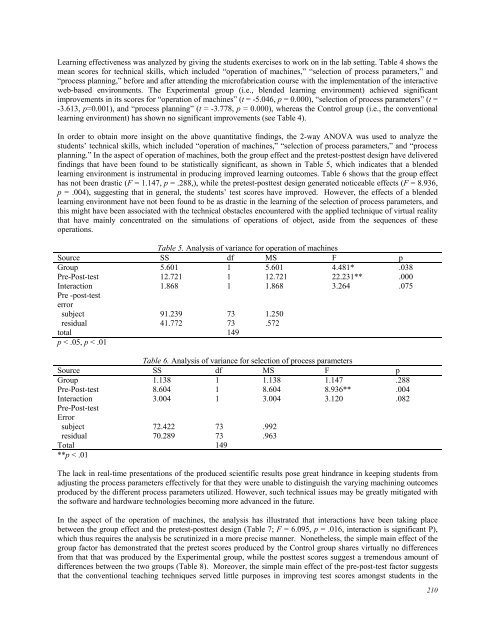Development of a Web-based System to Support Self-Directed ...
Development of a Web-based System to Support Self-Directed ...
Development of a Web-based System to Support Self-Directed ...
Create successful ePaper yourself
Turn your PDF publications into a flip-book with our unique Google optimized e-Paper software.
Learning effectiveness was analyzed by giving the students exercises <strong>to</strong> work on in the lab setting. Table 4 shows the<br />
mean scores for technical skills, which included “operation <strong>of</strong> machines,” “selection <strong>of</strong> process parameters,” and<br />
“process planning,” before and after attending the micr<strong>of</strong>abrication course with the implementation <strong>of</strong> the interactive<br />
web-<strong>based</strong> environments. The Experimental group (i.e., blended learning environment) achieved significant<br />
improvements in its scores for “operation <strong>of</strong> machines” (t = -5.046, p = 0.000), “selection <strong>of</strong> process parameters” (t =<br />
-3.613, p=0.001), and “process planning” (t = -3.778, p = 0.000), whereas the Control group (i.e., the conventional<br />
learning environment) has shown no significant improvements (see Table 4).<br />
In order <strong>to</strong> obtain more insight on the above quantitative findings, the 2-way ANOVA was used <strong>to</strong> analyze the<br />
students’ technical skills, which included “operation <strong>of</strong> machines,” “selection <strong>of</strong> process parameters,” and “process<br />
planning.” In the aspect <strong>of</strong> operation <strong>of</strong> machines, both the group effect and the pretest-posttest design have delivered<br />
findings that have been found <strong>to</strong> be statistically significant, as shown in Table 5, which indicates that a blended<br />
learning environment is instrumental in producing improved learning outcomes. Table 6 shows that the group effect<br />
has not been drastic (F = 1.147, p = .288,), while the pretest-posttest design generated noticeable effects (F = 8.936,<br />
p = .004), suggesting that in general, the students’ test scores have improved. However, the effects <strong>of</strong> a blended<br />
learning environment have not been found <strong>to</strong> be as drastic in the learning <strong>of</strong> the selection <strong>of</strong> process parameters, and<br />
this might have been associated with the technical obstacles encountered with the applied technique <strong>of</strong> virtual reality<br />
that have mainly concentrated on the simulations <strong>of</strong> operations <strong>of</strong> object, aside from the sequences <strong>of</strong> these<br />
operations.<br />
Table 5. Analysis <strong>of</strong> variance for operation <strong>of</strong> machines<br />
Source SS df MS F p<br />
Group 5.601 1 5.601 4.481* .038<br />
Pre-Post-test 12.721 1 12.721 22.231** .000<br />
Interaction<br />
1.868 1 1.868 3.264 .075<br />
Pre -post-test<br />
error<br />
subject 91.239 73 1.250<br />
residual 41.772 73 .572<br />
<strong>to</strong>tal 149<br />
p < .05, p < .01<br />
Table 6. Analysis <strong>of</strong> variance for selection <strong>of</strong> process parameters<br />
Source SS df MS F p<br />
Group 1.138 1 1.138 1.147 .288<br />
Pre-Post-test 8.604 1 8.604 8.936** .004<br />
Interaction<br />
3.004 1 3.004 3.120 .082<br />
Pre-Post-test<br />
Error<br />
subject 72.422 73 .992<br />
residual 70.289 73 .963<br />
Total 149<br />
**p < .01<br />
The lack in real-time presentations <strong>of</strong> the produced scientific results pose great hindrance in keeping students from<br />
adjusting the process parameters effectively for that they were unable <strong>to</strong> distinguish the varying machining outcomes<br />
produced by the different process parameters utilized. However, such technical issues may be greatly mitigated with<br />
the s<strong>of</strong>tware and hardware technologies becoming more advanced in the future.<br />
In the aspect <strong>of</strong> the operation <strong>of</strong> machines, the analysis has illustrated that interactions have been taking place<br />
between the group effect and the pretest-posttest design (Table 7; F = 6.095, p = .016, interaction is significant P),<br />
which thus requires the analysis be scrutinized in a more precise manner. Nonetheless, the simple main effect <strong>of</strong> the<br />
group fac<strong>to</strong>r has demonstrated that the pretest scores produced by the Control group shares virtually no differences<br />
from that that was produced by the Experimental group, while the posttest scores suggest a tremendous amount <strong>of</strong><br />
differences between the two groups (Table 8). Moreover, the simple main effect <strong>of</strong> the pre-post-test fac<strong>to</strong>r suggests<br />
that the conventional teaching techniques served little purposes in improving test scores amongst students in the<br />
210
















